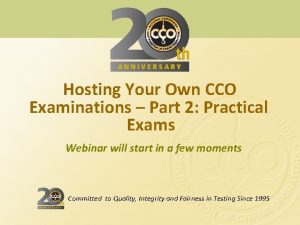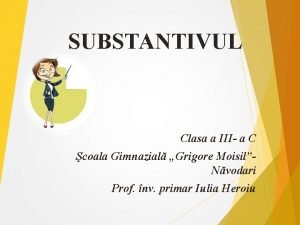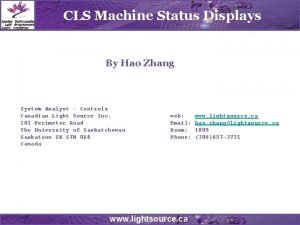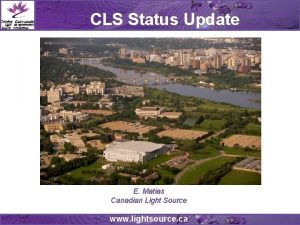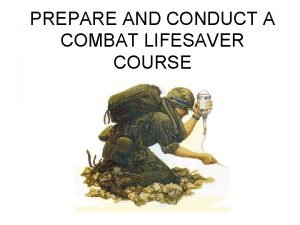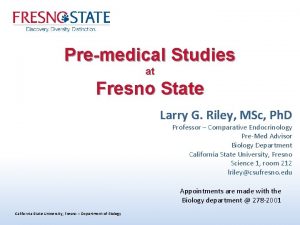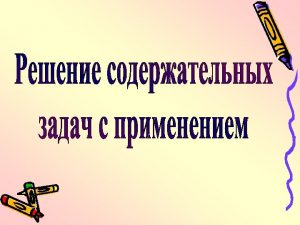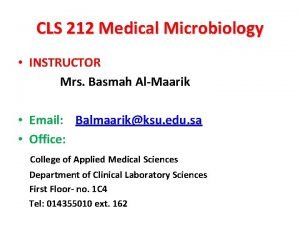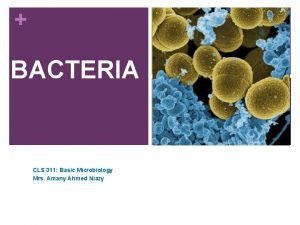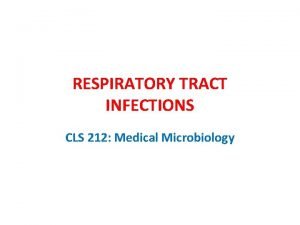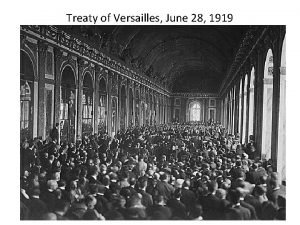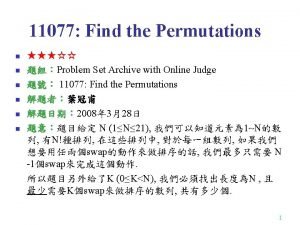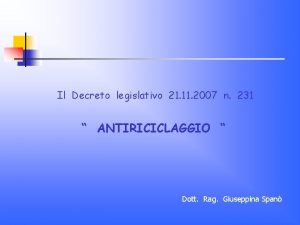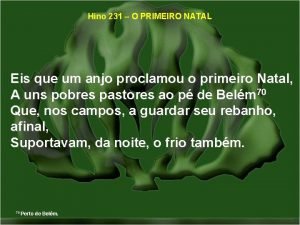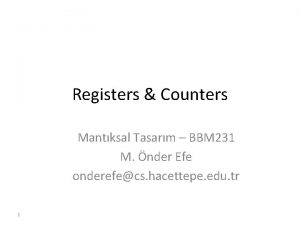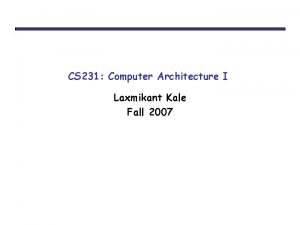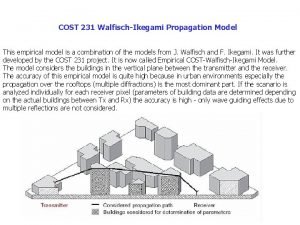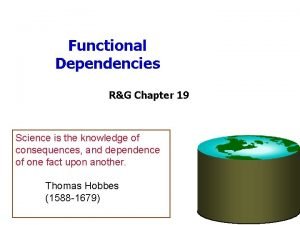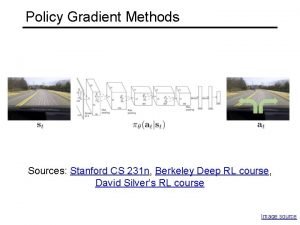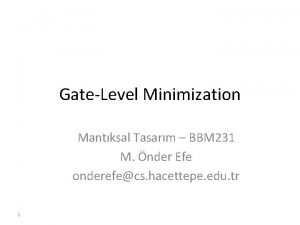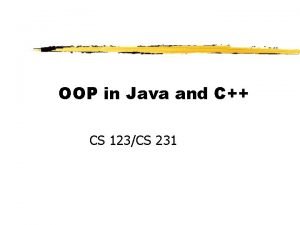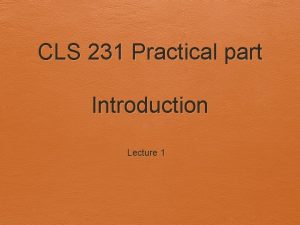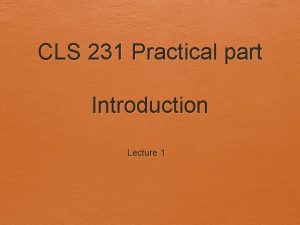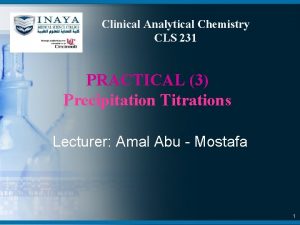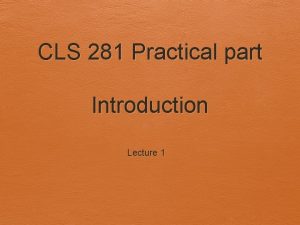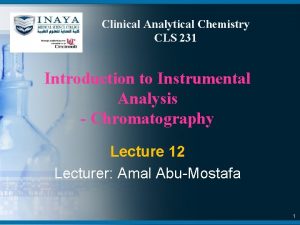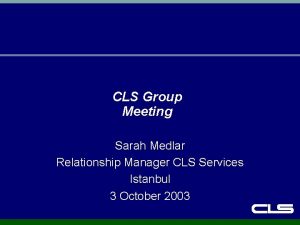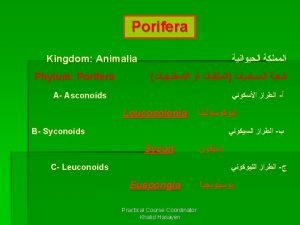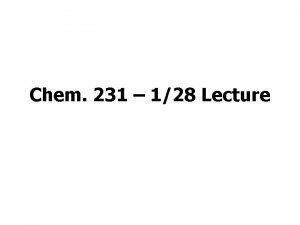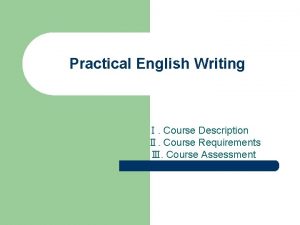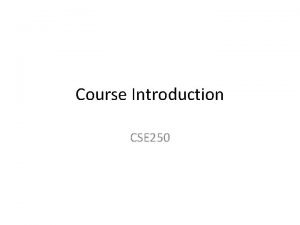CLS 231 Practical part Introduction Lecture 1 Course




















































- Slides: 52

CLS 231 Practical part Introduction Lecture 1

Course syllabus 1 - Basic laboratory equipment and procedures safety rules . 2 - Standardization of sodium hydroxide and hydrochloric acid solutions (2 lectures). 3 - Determination of bicarbonate in blood. 4 - Mercurimetric determination of blood and urine chloride. 5. Complexometric determination of calcium in milk. 6 - Determination of blood glucose by a Redox titration method . 7 - Determination of chloride by the Vohlard method. 8 - Gravimetric determination of chloride. 9 - Revision

Marking criteria 1 - Quiz ( 3 marks). 2 - Final lab exam ( 15 marks). 3 - Attendance and behaviour ( 2 marks ). 4 - lab report ( 5 marks). .

Outline 1 - laboratory regulations 2 - Emergency procedure. 3 - Safety rules and first aid procedures. 4 - Lab tools and signs. 5 - Units of concentration.

laboratory regulations 1 - Read each experiment thoroughly before entering the lab. 2 - Discard solids into the waste crocks. 3 - leave reagent bottles at the side shelves. 4 - Read the labels. 5 - Avoid using excessive amounts of reagents.

6 - Never return unused chemicals to the stock bottle. 7 - Don’t inset your own pipets or medicine droppers into the reagent bottles. 8 - Don’t lay down the stopper of a bottle. 9 - Don’t heavy glassware. 10 - Always maintain a clean work area in the laboratory.

11 - Wash glassware with water and a cleaner if needed. 12 - When heating a liquid in a test tube point it away in case it pumps.

Emergency procedure 1 - Notify the instructor or demonstrator immediately in case of accident. 2 - learn the location and proper use of fire extinguisher, blanket, first-aid kit. 3 - Spillage of corrosive chemicals must be reported.

Safety rules and first aid procedures 1 - Wear safety glasses in the lab. 2 - Don’t eat or drink in the lab. 3 - Never attempt unauthorized experiments. . 4 - Never leave heated laboratory reactions unattended.

6 - No practical jocks. 7 - Never dip pipets or spatulas into reagent bottles and don’t return unused portion to the stock bottles. 8 - Be familiar with emergency exit. 9 - Be prepared to administer first aid.

Lab tools 1 - Florence flask: - It is also known as a boiling flask. It is designed to be used for uniform heating and ease of swirling; it is produced in a number of different glass thicknesses to stand different types of use.

2 - Beaker : It is a simple container for stirring, mixing and heating liquids. They are generally cylindrical in shape, with a flat bottom.

3 - Funnel: Different kinds of funnels that have been adapted for these specialized applications in laboratory. Main usage is transferring liquids to other containers through filtration.

4 - filter flask: A filter flask is a flask fitted with a side arm for connecting to a vacuum source for fast filtering.

5 - Mortar and pestle: It is a tool used to grind and mix substances.

Graduated cylinder 5 - Graduated cylinder : used to measure the volume of a liquid. Graduated cylinders are generally more accurate and precise than laboratory flasks and beakers.

Powder funnel 6 - Powder funnel : It has a small and wide neck for fast pouring of powders.

Erlenmeyer flask 7 - Erlenmeyer flask: The Erlenmeyer is usually marked on the side (graduated) to indicate the approximate volume of contents, and has a spot of ground glass or enamel where it can be labeled with a pencil. It differs from the beaker in its tapered body and narrow neck.

Mohr pipette 8 - Mohr pipette : Also known as a Graduated pipette, it is used to measure the volume of the liquid dispensed, although not as accurately as a volumetric pipette.

Test tubes 9 - Test tubes: Test tubes are widely used by chemist to hold, mix, or heat small quantities of solid or liquid chemicals, especially for qualitative experiments and assays.

Crucible and cover 10 - Crucible and cover: A crucible is a ceramic container capable of withstanding extreme temperatures, whilst the cover is designed to prevent heat escaping from the crucible itself.

Test tube holder 11 - Test tube holder: The test tube holder is used to hold test tubes. They are used by squeezing the handles to open the other end, and inserting the test tube. Test tube holders are typically used when heating the test tube is necessary, or for when caustic materials are being handled.

Evaporating dish 12 - Evaporating dishes : Are used to evaporate excess solvents, most commonly water - to produce a concentrated solution or a solid precipitate of the dissolved substance.

Test tube brush 13 - Test tube brush: Designed to clean test tubes.

Thermometer 14 - Thermometer: It is a device that is used to measure temperature in different principles.

Test tube rack 15 - Test tube rack: it is used to hold/support test tubes containing chemicals waiting for further operations.

Buchner funnel 16 -Buchner funnel: It is used in filtrations.

Distilling flask 17 - A distilling flask: Is used to separate mixtures of two liquids with different boiling points. Distillation occurs when the flask is heated and the components of the mixture change from liquid to gas, with the lowest boiling point liquids changing first and liquids with the highest boiling points changing last.

Ring stand, with rings 18 - The ring stand : Used to support laboratory apparatus.

Burette clamp 19 - A burette clamp is used to fasten glassware into place on a ring stand. Other clamps are condenser and pinchcock clamps.

continue 20 - Bunsen burner: is used for heating, sterilization. 21 - wire gauze with asbestos center: It can be used to support a container (such as a beaker or flask) during heating as it helps to spread the heat evenly over the container.

Wing top 22 - A wing top : is an accessory that can be used with a Bunsen burner to provide more uniform flame.

Wire triangle 23 - wire triangle: It's composed of twisted wire running through three clay pipes in the shape of an equilateral triangle and is used to hold a crucible over the flame of a Bunsen burner.

Watch glass 24 - Watch glass: used in chemistry as a surface to evaporate a liquid, to hold solids while being weighed, or as a cover for a beaker. 25 - laboratory balance: Is an instrument that can be used to determine the weight and mass of an object.

26 - A burette is used to deliver solution in preciselymeasured, variable volumes. 27 - Pneumatic trough: used for collecting gases, such as hydrogen, oxygen and nitrogen.

Pipettes 1 - Transfer pipettes 2 - Graduated pipettes

Analytical balances `

Laboratory Signs and Symbols Biohazard Toxic Radioactive Oxidizing

General danger Electrical hazard Explosive Flammable

Corrosive Harmful

Calculating Concentration The concentration of a chemical solution refers to the amount of solute that is dissolved in a solvent. We normally think of a solute as a solid that is added to a solvent (e. g. , adding table salt to water), but the solute could just as easily exist in another phase. For example, if we add a small amount of ethanol to water, then the ethanol is the solute and the water is the solvent. If we add a smaller amount of water to a larger amount of ethanol, then the water could be the solute!

Units of Concentration may be expressed several different ways: 1 - percent composition by mass. 2 - volume percent. 3 - mole fraction. 4 - molarity. 5 - molality. 6 - normality.

Percent Composition by Mass (%) This is the mass of the solute divided by the mass of the solution (mass of solute plus mass of solvent), multiplied by 100. Example: Determine the percent composition by mass of a 100 g salt solution which contains 20 g salt. Solution: 20 g Na. Cl / 100 g solution x 100 = 20% Na. Cl solution

Volume Percent (% v/v) Volume percent or volume/volume percent most often is used when preparing solutions of liquids. Volume percent is defined as: v/v % = [(volume of solute)/(volume of solution)] x 100%. Example: wine is about 12% v/v ethanol. This means there are 12 ml ethanol for every 100 ml of wine.

Mole Fraction (X) This is the number of moles of a compound divided by the total number of moles of all chemical species in the solution. Keep in mind, the sum of all mole fractions in a solution always equals 1. Example: What are the mole fractions of the components of the solution formed when 92 g glycerol is mixed with 90 g water? (molecular weight water = 18; molecular weight of glycerol = 92)

Solution: 90 g water = 90 g x 1 mol / 18 g = 5 mol water 92 g glycerol = 92 g x 1 mol / 92 g = 1 mol glycerol totalmol = 5 + 1 = 6 mol xwater = 5 mol / 6 mol = 0. 833 x glycerol = 1 mol / 6 mol = 0. 167 It'sa good idea to check your math by making sure the mole fractions add up to 1: xwater + xglycerol =. 833 + 0. 167 = 1. 000

Molarity (M) Molarity is probably the most commonly used unit of concentration. It is the number of moles of solute per liter of solution (not necessarily the same as the volume of solvent!). Example: What is the molarity of a solution made when water is added to 11 g Ca. Cl 2 to make 100 m. L of solution? Solution: 11 g Ca. Cl 2 / (110 g Ca. Cl 2 / mol Ca. Cl 2) = 0. 10 mol Ca. Cl 2 100 m. L x 1 L / 1000 m. L = 0. 10 L molarity= 0. 10 mol / 0. 10 L molarity = 1. 0 M

Molality (m) Molality is the number of moles of solute per kilogram of solvent. Because the density of water at 25°C is about 1 kilogram per liter, molality is approximately equal to molarity for dilute aqueous solutions at this temperature. This is a useful approximation, but remember that it is only an approximation and doesn't apply when the solution is at a different temperature, isn't dilute, or uses a solvent other than water.

Example: What is the molality of a solution of 10 g Na. OH i 500 g water? Solution: 10 g Na. OH / (40 g Na. OH / 1 mol Na. OH) = 0. 25 mol Na. OH 500 g water x 1 kg / 1000 g = 0. 50 kg water molality = 0. 25 mol / 0. 50 kg molality = 0. 05 M / kg molality = 0. 50 m

Normality (N) Normality is equal to the gram equivalent weight of a solute per liter of solution. A gram equivalent weight or equivalent is a measure of the reactive capacity of a given molecule. Normality is the only concentration unit that is reaction dependent. Example: 1 M sulfuric acid (H 2 SO 4) is 2 N for acid-base reactions because each mole of sulfuric acid provides 2 moles of H+ ions. On the other hand, 1 M sulfuric acid is 1 N for sulfate precipitation, since 1 mole of sulfuric acid provides 1 mole of sulfate ions.

Dilutions You dilute a solution whenever you add solvent to a solution. Adding solvent results in a solution of lower concentration. You can calculate the concentration of a solution following a dilution by applying this equation: Mi. Vi = Mf. Vf where M is molarity, V is volume, and the subscripts i and f refer to the initial and final values.

Example: How many millilieters of 5. 5 M Na. OH are needed to prepare 300 m. L of 1. 2 M Na. OH? Solution: 5. 5 M x V 1 = 1. 2 M x 0. 3 L / 5. 5 M V 1 = 0. 065 L V 1 = 65 m. L
 Reinforcement lap lengths eurocodes
Reinforcement lap lengths eurocodes 01:640:244 lecture notes - lecture 15: plat, idah, farad
01:640:244 lecture notes - lecture 15: plat, idah, farad Cco practical exam
Cco practical exam Dentalized d
Dentalized d Sfsu cls program
Sfsu cls program Cls in c#
Cls in c# Dotnetframe
Dotnetframe Substantivul clasa a treia
Substantivul clasa a treia Cls machine
Cls machine Cls status
Cls status Combat lifesaver powerpoint
Combat lifesaver powerpoint Fresno state cls program
Fresno state cls program Dibels scoring chart 1st grade
Dibels scoring chart 1st grade Cls 212
Cls 212 Disadvantages of fermentation
Disadvantages of fermentation Randomize timer
Randomize timer Cls 212
Cls 212 Cls settlement timeline
Cls settlement timeline Ahimed cls
Ahimed cls Cal state la cls program
Cal state la cls program Pneumonia classification
Pneumonia classification Acf 231
Acf 231 Article 231 of the treaty of versailles
Article 231 of the treaty of versailles 132 213
132 213 Pa msu
Pa msu Legge 231 del 2007
Legge 231 del 2007 Eis que um anjo proclamou o primeiro natal
Eis que um anjo proclamou o primeiro natal Gezang 231
Gezang 231 Application of shift register
Application of shift register Cs231
Cs231 Cost 231 walfisch-ikegami model
Cost 231 walfisch-ikegami model Draw 231 with base ten blocks
Draw 231 with base ten blocks 040 231 3666
040 231 3666 Cs 231 n
Cs 231 n Stanford 231n
Stanford 231n Bbm 231
Bbm 231 Maksud 231
Maksud 231 German territorial losses ww1
German territorial losses ww1 123cs
123cs Toastmasters timer sheet
Toastmasters timer sheet Potential gradient
Potential gradient Electric field strength formula
Electric field strength formula Cs 231 n
Cs 231 n Cs 231 n
Cs 231 n Coco
Coco Soft vs hard attention
Soft vs hard attention Disadvantages of cavity wall
Disadvantages of cavity wall Course number and title
Course number and title Course interne moyenne externe
Course interne moyenne externe Kinicki management a practical introduction
Kinicki management a practical introduction Read management: a practical introduction
Read management: a practical introduction Practical research
Practical research Management: a practical introduction
Management: a practical introduction


